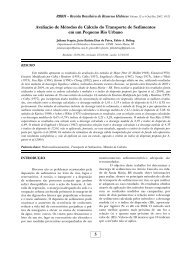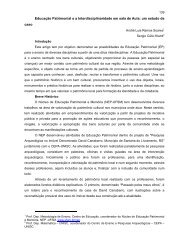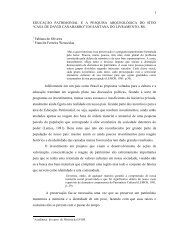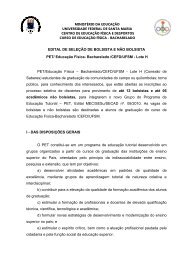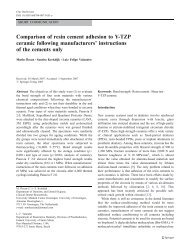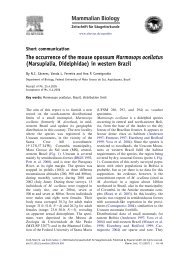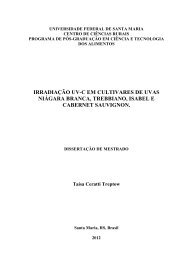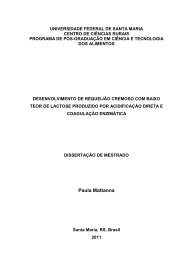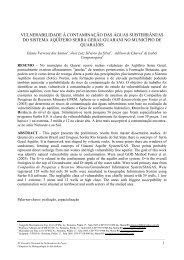DESENVOLVIMENTO E CARACTERIZAÇÃO FÃSICO ... - UFSM
DESENVOLVIMENTO E CARACTERIZAÇÃO FÃSICO ... - UFSM
DESENVOLVIMENTO E CARACTERIZAÇÃO FÃSICO ... - UFSM
Create successful ePaper yourself
Turn your PDF publications into a flip-book with our unique Google optimized e-Paper software.
64<br />
The sensory analysis of jelly palm wine assessed the acceptability of the beverage by the<br />
consumers with respect to the aroma, flavor, general acceptability and also the purchasing<br />
intention. The results showed significant differences (p ≤ 0.05) in the acceptance of the five samples<br />
of jelly palm wine for the evaluated attributes (flavor and general acceptability) as showed in table<br />
3. The treatment D2T10 showed the high mean value for the aroma assessment followed by the<br />
treatment M2T10. Besides the different values, the treatments were not statistically different which<br />
shows that jelly palm wine aroma was not the main parameter for differentiation among the applied<br />
treatments. For the flavor assessment the treatment D2T10 was statistically different to the<br />
treatment M7T20 that possessed the lower mean value being considered the worst wine for the<br />
consumers with respect to this parameter. General acceptability was also high for the treatment<br />
D2T10 differing statistically from the treatment M7T20. Consumers answered the subjective<br />
question of "most liked" and "least liked" for each sample of wine. In general consumers answered<br />
the natural aroma of jelly palm fruit as the most liked attribute for the for all treatments and the<br />
high acidity as the least liked for the treatments fermented at 20 ºC. The attributes aroma, flavor<br />
and general acceptability were analyzed by graphs of frequency distribution of the hedonic values<br />
assigned to each sample (Figures. 2, 3, and 4). The same was done for purchase intention (Figure<br />
5). The higher acceptability for the treatment D2T10 with respect to flavor can be evidenced in<br />
Fig. 2. This sample accumulated 40% of the opinion of consumers between 7 (like moderately)<br />
and 9 (like extremely) on the hedonic scale for flavor. The treatment (M2T10) had a value close<br />
(35%), while the treatment M7T20 possessed 10%. To the aroma, the treatment D2T10 had 35%<br />
of the preference by consumers between 7 and 9 on the hedonic scale. The treatment M7T20 that<br />
did not differ statistically had 27% (Fig 3). The general acceptability had a similar behavior that<br />
for flavor assessment. Treatment D2T10 had 39%. For the purchase intention the results show a<br />
higher percentage to the item 3 of the questionnaire (maybe/maybe not) for the treatment D2T10<br />
with 31% of the purchasing intention (figure 4).<br />
The results found for the sensory evaluation will in agreement with those obtained for the<br />
volatile composition of the jelly palm wine. As reported by Bernardi et al., (2013), hexanoic acid<br />
assigns to the beverage a strong taste of rancid which may not be pleasant for the major of<br />
consumers. As showed in Table 2, the treatments fermented at 20 ºC possessed the high values for<br />
hexanoic acid while the wine fermented with must dilution at 10 ºC showed the lower value. Also,



